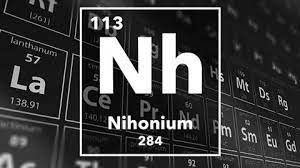Identity.
Nihonium, element 113, is a fleeting celebrity of the periodic table.
This synthetic heavyweight doesn't grace nature's stage, only
appearing briefly in labs through high-energy collisions. Born in
2003, its existence is a testament to scientific collaboration, named
after the "Land of the Rising Sun" where it was discovered. With a
symbol of "Nh," this radioactive superstar lives for a mere 10
seconds, yet its presence opens doors to understanding the limits of
the periodic table and the exotic world of superheavy elements. So,
while you won't find it in your pocket, nihonium shines as a beacon of
human curiosity, pushing the boundaries of our knowledge and igniting
the imagination for future scientific explorations.
History.
The story of nihonium, element 113, began not with a bang, but with a
whisper. In 2003, two teams, one Japanese and one Russian-American,
reported creating this elusive element, but confirmation remained
years away. Think of it like whispers of a mythical creature echoing
through the scientific community.
Finally, in 2012, a Japanese team led by Kosuke Morita solidified
the whispers into reality. They successfully created nihonium by
bombarding bismuth with zinc ions, ushering the element onto the
world stage. But like a fleeting comet, each atom existed for a
mere 10 seconds before decaying. The confirmation process,
involving independent teams verifying the discovery, took another
three years.
In 2015, the International Union of Pure and Applied Chemistry
(IUPAC) finally recognized the discovery, awarding priority to the
Japanese team. The element was officially christened "nihonium," a
tribute to its birthplace, "Land of the Rising Sun." While
nihonium remains confined to labs, its discovery marks a giant
leap in our understanding of superheavy elements and the
ever-expanding periodic table. Its story, though fleeting, is a
testament to scientific collaboration, perseverance, and the human
quest to explore the unseen.
Usage.
Show drafts While nihonium's fleeting existence means it can't power
your phone or cure diseases, its significance lies in unlocking the
secrets of the unseen. This synthetic element serves as a stepping
stone, helping scientists peer deeper into the realm of superheavy
elements and test the boundaries of the periodic table. Think of it as
a key, opening doors to future discoveries that could revolutionize
fields like nuclear physics and our understanding of the universe
itself. So, while nihonium won't be in your next gadget, its role in
scientific exploration makes it a valuable piece in the puzzle of
knowledge.
-
Undrstanding the limits of the periodic table: Nihonium's
existence helps scientists understand the stability of nuclei and
the boundaries of element creation. By studying its decay patterns
and properties, researchers can refine models and predictions for
even heavier elements that might exist.
-
Explroing superheavy elements: Nihonium acts as a stepping
stone in the research of superheavy elements, pushing the
boundaries of our knowledge about nuclear physics and potentially
leading to the discovery of new elements with unique properties.
-
Testing Nucler Theories: Studying the behavior of nuclei
like Nihonium allows scientists to test and refine theoretical
models in nuclear physics, potentially leading to advancements in
areas like nuclear energy and nuclear medicine.
-
Fostering international collaboration: The discovery of
Nihonium involved collaboration between Japanese and
Russian/American scientists, highlighting the importance of
international cooperation in pushing the frontiers of scientific
discovery.
Some of the benefits of using Nihonium are:
-
Nihonium's existence helps us understand the stability of atomic
nuclei and the theoretical limits of element creation. Studying
its properties and decay helps refine models and predictions for
even heavier elements that might exist.
-
Nihonium serves as a stepping stone in the research of superheavy
elements, pushing the boundaries of our knowledge about nuclear
physics and potentially leading to the discovery of new elements
with unique properties.
-
Studying the behavior of nuclei like Nihonium allows scientists to
test and refine theoretical models in nuclear physics, potentially
leading to advancements in areas like nuclear energy and nuclear
medicine.
-
The discovery of Nihonium involved collaboration between
scientists from multiple countries, highlighting the importance of
international cooperation in pushing the frontiers of scientific
discovery.
Sources.
Unfortunately, roentgenium doesn't exist naturally like gold or iron,
so it doesn't have distinct "sources" in the traditional sense.
Instead, it's synthesized in highly specialized laboratories using
powerful machines called particle accelerators. The most common method
involves bombarding a target atom (like Bismuth) with another element
(like Nickel) to fuse them into roentgenium. This process creates
incredibly few atoms, each lasting only milliseconds before decaying
due to its extreme radioactivity. While there aren't "sources" in the
usual sense, research facilities like GSI Helmholtz Centre in Germany
have played a crucial role in creating and studying roentgenium,
offering a glimpse into this fascinating and fleeting element.
